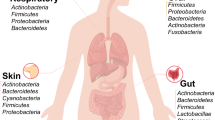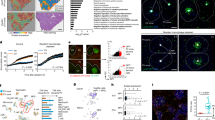Abstract
Complex interactions between the host and the gut microbiota govern intestinal homeostasis but remain poorly understood. Here we reveal a relationship between gut microbiota and caspase recruitment domain family member 9 (CARD9), a susceptibility gene for inflammatory bowel disease (IBD) that functions in the immune response against microorganisms. CARD9 promotes recovery from colitis by promoting interleukin (IL)-22 production, and Card9−/− mice are more susceptible to colitis. The microbiota is altered in Card9−/− mice, and transfer of the microbiota from Card9−/− to wild-type, germ-free recipients increases their susceptibility to colitis. The microbiota from Card9−/− mice fails to metabolize tryptophan into metabolites that act as aryl hydrocarbon receptor (AHR) ligands. Intestinal inflammation is attenuated after inoculation of mice with three Lactobacillus strains capable of metabolizing tryptophan or by treatment with an AHR agonist. Reduced production of AHR ligands is also observed in the microbiota from individuals with IBD, particularly in those with CARD9 risk alleles associated with IBD. Our findings reveal that host genes affect the composition and function of the gut microbiota, altering the production of microbial metabolites and intestinal inflammation.
This is a preview of subscription content, access via your institution
Access options
Subscribe to this journal
Receive 12 print issues and online access
$209.00 per year
only $17.42 per issue
Buy this article
- Purchase on Springer Link
- Instant access to full article PDF
Prices may be subject to local taxes which are calculated during checkout






Similar content being viewed by others
References
Silva, M.J. et al. The multifaceted role of commensal microbiota in homeostasis and gastrointestinal diseases. J. Immunol. Res. 2015, 321241 (2015).
Molodecky, N.A. et al. Increasing incidence and prevalence of the inflammatory bowel diseases with time, based on systematic review. Gastroenterology 142, 46–54.e42; quiz e30 (2012).
Ananthakrishnan, A.N. Epidemiology and risk factors for IBD. Nat. Rev. Gastroenterol. Hepatol. 12, 205–217 (2015).
Lanternier, F. et al. Inherited CARD9 deficiency in otherwise healthy children and adults with Candida species–induced meningoencephalitis, colitis, or both. J. Allergy Clin. Immunol. 135, 1558–1568.e2 (2015).
Hsu, Y.-M.S.M. et al. The adaptor protein CARD9 is required for innate immune responses to intracellular pathogens. Nat. Immunol. 8, 198–205 (2007).
Goodridge, H.S. et al. Differential use of CARD9 by dectin-1 in macrophages and dendritic cells. J. Immunol. 182, 1146–1154 (2009).
Hara, H. et al. Cell-type-specific regulation of ITAM-mediated NF-κB activation by the adaptors CARMA1 and CARD9. J. Immunol. 181, 918–930 (2008).
Sokol, H. et al. CARD9 mediates intestinal epithelial cell restitution, T helper 17 responses, and control of bacterial infection in mice. Gastroenterology 145, 591–601 (2013).
Darfeuille-Michaud, A. et al. High prevalence of adherent-invasive Escherichia coli associated with ileal mucosa in Crohn's disease. Gastroenterology 127, 412–421 (2004).
Sokol, H. et al. Faecalibacterium prausnitzii is an anti-inflammatory commensal bacterium identified by gut microbiota analysis of Crohn's disease patients. Proc. Natl. Acad. Sci. USA 105, 16731–16736 (2008).
Atarashi, K. et al. Treg induction by a rationally selected mixture of clostridia strains from the human microbiota. Nature 500, 232–236 (2013).
Zelante, T. et al. Tryptophan catabolites from microbiota engage aryl hydrocarbon receptor and balance mucosal reactivity via interleukin-22. Immunity 39, 372–385 (2013).
Rutz, S., Eidenschenk, C. & Ouyang, W. IL-22, not simply a TH17 cytokine. Immunol. Rev. 252, 116–132 (2013).
Sonnenberg, G.F., Fouser, L.A. & Artis, D. Border patrol: regulation of immunity, inflammation, and tissue homeostasis at barrier surfaces by IL-22. Nat. Immunol. 12, 383–390 (2011).
Stelter, C. et al. Salmonella-induced mucosal lectin RegIII-β kills competing gut microbiota. PLoS One 6, e20749 (2011).
De Luca, A. et al. IL-22 defines a novel immune pathway of antifungal resistance. Mucosal Immunol. 3, 361–373 (2010).
Ishigame, H. et al. Differential roles of interleukin (IL)-17A and IL-17F in host defense against mucoepithelial bacterial infection and allergic responses. Immunity 30, 108–119 (2009).
Wu, W., Hsu, Y.-M.S.M., Bi, L., Songyang, Z. & Lin, X. CARD9 facilitates microbe-elicited production of reactive oxygen species by regulating the LyGDI–Rac1 complex. Nat. Immunol. 10, 1208–1214 (2009).
Iliev, I.D. et al. Interactions between commensal fungi and the C-type lectin receptor dectin-1 influence colitis. Science 336, 1314–1317 (2012).
Richard, M.L., Lamas, B., Liguori, G., Hoffmann, T.W. & Sokol, H. Gut fungal microbiota: the yin and yang of inflammatory bowel disease. Inflamm. Bowel Dis. 21, 656–665 (2015).
Segata, N. et al. Metagenomic biomarker discovery and explanation. Genome Biol. 12, R60 (2011).
Kim, K. et al. Interleukin-22 promotes epithelial cell transformation and breast tumorigenesis via MAP3K8 activation. Carcinogenesis 35, 1352–1361 (2014).
Andoh, A. et al. Interleukin-22, a member of the IL-10 subfamily, induces inflammatory responses in colonic subepithelial myofibroblasts. Gastroenterology 129, 969–984 (2005).
Sabat, R., Ouyang, W. & Wolk, K. Therapeutic opportunities of the IL-22–IL-22R1 system. Nat. Rev. Drug Discov. 13, 21–38 (2014).
Pickert, G. et al. STAT3 links IL-22 signaling in intestinal epithelial cells to mucosal wound healing. J. Exp. Med. 206, 1465–1472 (2009).
Spits, H. et al. Innate lymphoid cells—a proposal for uniform nomenclature. Nat. Rev. Immunol. 13, 145–149 (2013).
Chung, K.-T.T. & Gadupudi, G.S. Possible roles of excess tryptophan metabolites in cancer. Environ. Mol. Mutagen. 52, 81–104 (2011).
Jin, U.-H.H. et al. Microbiome-derived tryptophan metabolites and their aryl-hydrocarbon-receptor-dependent agonist and antagonist activities. Mol. Pharmacol. 85, 777–788 (2014).
Lee, J.S. et al. AHR drives the development of gut ILC22 cells and postnatal lymphoid tissues via pathways dependent on, and independent of, Notch. Nat. Immunol. 13, 144–151 (2012).
Zenewicz, L.A. et al. IL-22 deficiency alters colonic microbiota to be transmissible and colitogenic. J. Immunol. 190, 5306–5312 (2013).
Jostins, L. et al. Host–microbe interactions have shaped the genetic architecture of inflammatory bowel disease. Nature 491, 119–124 (2012).
Wikoff, W.R. et al. Metabolomics analysis reveals large effects of gut microflora on mammalian blood metabolites. Proc. Natl. Acad. Sci. USA 106, 3698–3703 (2009).
Behnsen, J. et al. The cytokine IL-22 promotes pathogen colonization by suppressing related commensal bacteria. Immunity 40, 262–273 (2014).
Lin, L. & Xu, X. Indole-3-acetic acid production by endophytic Streptomyces sp. En-1 isolated from medicinal plants. Curr. Microbiol. 67, 209–217 (2013).
Hara, H. et al. The adaptor protein CARD9 is essential for the activation of myeloid cells through ITAM-associated and Toll-like receptors. Nat. Immunol. 8, 619–629 (2007).
Suau, A. et al. Direct analysis of genes encoding 16S rRNA from complex communities reveals many novel molecular species within the human gut. Appl. Environ. Microbiol. 65, 4799–4807 (1999).
Tomas, J. et al. Primocolonization is associated with colonic epithelial maturation during conventionalization. FASEB J. 27, 645–655 (2013).
Schmieder, R. & Edwards, R. Quality control and preprocessing of metagenomic datasets. Bioinformatics 27, 863–864 (2011).
Magocč, T. & Salzberg, S.L. FLASH: fast length adjustment of short reads to improve genome assemblies. Bioinformatics 27, 2957–2963 (2011).
Caporaso, J.G. et al. QIIME allows analysis of high-throughput community sequencing data. Nat. Methods 7, 335–336 (2010).
Edgar, R.C. Search and clustering orders of magnitude faster than BLAST. Bioinformatics 26, 2460–2461 (2010).
McDonald, D. et al. An improved Greengenes taxonomy with explicit ranks for ecological and evolutionary analyses of bacteria and archea. ISME J. 6, 610–618 (2012).
Kõljalg, U. et al. Toward a unified paradigm for sequence-based identification of fungi. Mol. Ecol. 22, 5271–5277 (2013).
Thioulouse, J., Chessel, D., Dolédec, S. & Olivier, J. ADE-4: a multivariate analysis and graphical display software. Stat. Comput. 7, 75–83 (1997).
Bolstad, B.M., Irizarry, R.A., Astrand, M. & Speed, T.P. A comparison of normalization methods for high-density oligonucleotide array data based on variance and bias. Bioinformatics 19, 185–193 (2003).
Smyth, G.K. Linear models and empirical Bayes methods for assessing differential expression in microarray experiments. Stat. Appl. Genet. Mol. Biol. 3, e3 (2004).
Huang, W., Sherman, B.T. & Lempicki, R.A. Systematic and integrative analysis of large gene lists using DAVID bioinformatics resources. Nat. Protoc. 4, 44–57 (2009).
Huang, W., Sherman, B.T. & Lempicki, R.A. Bioinformatics enrichment tools: paths toward the comprehensive functional analysis of large gene lists. Nucleic Acids Res. 37, 1–13 (2009).
Zhao, B. et al. Common commercial and consumer products contain activators of the aryl hydrocarbon (dioxin) receptor. PLoS One 8, e56860 (2013).
He, G., Zhao, B. & Denison, M.S. Identification of benzothiazole derivatives and polycyclic aromatic hydrocarbons as aryl hydrocarbon receptor agonists present in tire extracts. Environ. Toxicol. Chem. 30, 1915–1925 (2011).
Gao, X. et al. Metabolite analysis of human fecal water by gas chromatography–mass spectrometry with ethyl chloroformate derivatization. Anal. Biochem. 393, 163–175 (2009).
Maneglier, B. et al. Simultaneous measurement of kynurenine and tryptophan in human plasma and supernatants of cultured human cells by HPLC with coulometric detection. Clin. Chem. 50, 2166–2168 (2004).
Acknowledgements
We thank the members of the ANAXEM germ-free platform, the members of the animal facilities of INRA, and T. Ledent of the animal facilities of Saint-Antoine Hospital for their assistance in mouse care; M. Moroldo and J. Lecardonnel from the CRB GADIE core facility for technical assistance in performing the microarray analyses; S. Dumont for technical help in histology and immunochemistry; and C. Aubry, N.M. Breyner, F. Chain, S. Le Guin, C. Cherbuy, N. Lapaque, and D. Skurnik for fruitful discussions and technical help. We also thank E. Drouet and the Clinical Research Assistant team of Unité de Recherche Clinique de l'Est Parisien for their help in obtaining samples from patients with IBD. Ido1−/− and Il22−/− mice were provided by S. Taleb (INSERM Unit 970) and B. Ryffel (CNRS, UMR7355), respectively. The H1L1.1c2 cell line was provided by M.S. Denison (University of California, Davis). Funding was provided by Equipe ATIP–Avenir 2012 (H.S.), INSERM–ITMO SP 2013 (H.S.) and ECCO grant 2012 (H.S.).
Author information
Authors and Affiliations
Contributions
B.L., M.L.R., and H.S. conceived and designed the study, performed data analysis, and wrote the manuscript; B.L. designed and conducted all experiments, unless otherwise indicated; V.L. designed and performed the AHR activity experiments; G.D.C., C.B., S.J., T.W.H., J.M.N., L. Brot, F.M., and M.-L.M. provided technical help for the in vitro and in vivo experiments; H.-P.P. conducted the bioinformatics studies and analyzed the microarray experiments; J.-M.L. performed and analyzed HPLC experiments; S.T. provided material from the Ido1−/− mice and discussed the results; A.C.-M. and B.R. provided material from the Il22−/− mice and discussed the results; H.S., J.C., I.N.-L., A.B., L. Beaugerie, and P.S. provided data and samples for the patients with IBD; B.L., M.L.R., R.J.X., P.L., and H.S. discussed the experiments and results.
Corresponding author
Ethics declarations
Competing interests
The authors declare no competing financial interests.
Supplementary information
Supplementary Text and Figures
Supplementary Figures 1–15, Supplementary Tables 1 and 2, and Supplementary legend (PDF 2311 kb)
Rights and permissions
About this article
Cite this article
Lamas, B., Richard, M., Leducq, V. et al. CARD9 impacts colitis by altering gut microbiota metabolism of tryptophan into aryl hydrocarbon receptor ligands. Nat Med 22, 598–605 (2016). https://doi.org/10.1038/nm.4102
Received:
Accepted:
Published:
Issue Date:
DOI: https://doi.org/10.1038/nm.4102
This article is cited by
-
The gut-liver axis in hepatobiliary diseases
Inflammation and Regeneration (2024)
-
Dissecting the respective roles of microbiota and host genetics in the susceptibility of Card9−/− mice to colitis
Microbiome (2024)
-
Metabolic network of the gut microbiota in inflammatory bowel disease
Inflammation and Regeneration (2024)
-
The role of gut microbiota in human metabolism and inflammatory diseases: a focus on elderly individuals
Annals of Microbiology (2024)
-
Utilization of the microbiome in personalized medicine
Nature Reviews Microbiology (2024)



